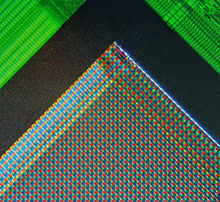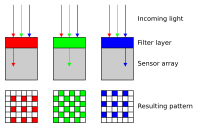Image sensor

An image sensor or imaging sensor is a sensor that detects and conveys the information that constitutes an image. It does so by converting the variable attenuation of light waves (as they pass through or reflect off objects) into signals, small bursts of current that convey the information. The waves can be light or other electromagnetic radiation. Image sensors are used in electronic imaging devices of both analog and digital types, which include digital cameras, camera modules, medical imaging equipment, night vision equipment such as thermal imaging devices, radar, sonar, and others. As technology changes, digital imaging tends to replace analog imaging.
Early analog sensors for visible light were video camera tubes. Currently, used types are semiconductor charge-coupled devices (CCD) or active pixel sensors in complementary metal–oxide–semiconductor (CMOS) or N-type metal-oxide-semiconductor (NMOS, Live MOS) technologies. Analog sensors for invisible radiation tend to involve vacuum tubes of various kinds. Digital sensors include flat panel detectors.
CCD vs CMOS technology


Today, most digital cameras use a CMOS sensor, because CMOS sensors perform better than CCDs. An example is the fact that they incorporate an integrated circuit, helping reduce costs. CCD is still in use for cheap low entry cameras, but weak in burst mode.[1] Both types of sensor accomplish the same task of capturing light and converting it into electrical signals.
Each cell of a CCD image sensor is an analog device. When light strikes the chip it is held as a small electrical charge in each photo sensor. The charges in the line of pixels nearest to the (one or more) output amplifiers are amplified and output, then each line of pixels shifts its charges one line closer to the amplifier(s), filling the empty line closest to the amplifiers(s). This process is then repeated until all the lines of pixels have had their charge amplified and output.[2]
A CMOS image sensor has an amplifier for each pixel compared to the few amplifiers of a CCD. This results in less area for the capture of photons than a CCD, but this problem has been overcome by using microlenses in front of each photodiode, which focus light into the photodiode that would have otherwise hit the amplifier and not be detected.[3] Some CMOS imaging sensors also use Back-side illumination to increase the number of photons that hit the photodiode.
CMOS sensors can potentially be implemented with fewer components, use less power, and/or provide faster readout than CCD sensors.[4] They are also less vulnerable to static electricity discharges.
Another hybrid CCD/CMOS architecture, sold under the name "sCMOS," consists of CMOS readout integrated circuits (ROICs) that are bump bonded to a CCD imaging substrate – a technology that was developed for infrared staring arrays and now adapted to silicon-based detector technology.[5] Another approach is to utilize the very fine dimensions available in modern CMOS technology to implement a CCD like structure entirely in CMOS technology. This can be achieved by separating individual poly-silicon gates by a very small gap. These hybrid sensors are still in the research phase and can potentially harness the benefits of both CCD and CMOS imagers.[6]
Performance
There are many parameters that can be used to evaluate the performance of an image sensor, including dynamic range, signal-to-noise ratio, and low-light sensitivity. For sensors of comparable types, the signal-to-noise ratio and dynamic range improve as the size increases.
Color separation


There are several main types of color image sensors, differing by the type of color-separation mechanism:
- Bayer filter sensor, low-cost and most common, using a color filter array that passes red, green, or blue light to selected pixel sensors, forming interlaced grids sensitive to red, green, and blue – the missing color samples are interpolated using a demosaicing algorithm. In order to avoid interpolated color information, techniques like color co-site sampling use a piezo mechanism to shift the color sensor in pixel steps. The Bayer filter sensors also include back-illuminated sensors, where the light enters the sensitive silicon from the opposite side of where the transistors and metal wires are, such that the metal connections on the devices side are not an obstacle for the light, and the efficiency is higher.[7][8]
- Foveon X3 sensor, using an array of layered pixel sensors, separating light via the inherent wavelength-dependent absorption property of silicon, such that every location senses all three color channels.
- 3CCD, using three discrete image sensors, with the color separation done by a dichroic prism.
Specialty sensors

Special sensors are used in various applications such as thermography, creation of multi-spectral images, video laryngoscopes, gamma cameras, sensor arrays for x-rays, and other highly sensitive arrays for astronomy.[citation needed]
While in general digital cameras use a flat sensor, Sony prototyped a curved sensor in 2014 to reduce/eliminate Petzval field curvature that occurs with a flat sensor. Use of a curved sensor allows a shorter and smaller diameter of the lens with reduced elements and components with greater aperture and reduced light fall-off at the edge of the photo.[10]
Sensors used in digital cameras
Width (px) Height (px) Aspect ratio Actual pixel count Megapixels Camera examples 100 100 1:110,000 0.01 Kodak (by Steven Sasson) Prototype (1975) 640 480 
307,200 0.3 Apple QuickTake 100 (1994) 832 608 
505,856 0.5 Canon Powershot 600 (1996) 1,024 768 
786,432 0.8 Olympus D-300L (1996) 1024 1024 1:11,048,576 1.0 Nikon NASA F4 (1991) 1,280 960 
1,228,800 1.3 Fujifilm DS-300 (1997) 1,280 1,024 5:41,310,720 1.3 Fujifilm MX-700, Fujifilm MX-1700 (1999), Leica Digilux (1998), Leica Digilux Zoom (2000) 1,600 1,200 
1,920,000 2 Nikon Coolpix 950, Samsung GT-S3500 2,012 1,324 
2,663,888 2.74 Nikon D1 2,048 1,536 
3,145,728 3 Canon PowerShot A75, Nikon Coolpix 995 2,272 1,704 
3,871,488 4 Olympus Stylus 410, Contax i4R (although CCD is actually square 2,272×2,272) 2,464 1,648 
4,060,672 4.1 Canon 1D 2,560 1,920 
4,915,200 5 Olympus E-1, Sony Cyber-shot DSC-F707, Sony Cyber-shot DSC-F717 2,816 2,112 
5,947,392 5.9 Olympus Stylus 600 Digital 3,008 2,000 
6,016,000 6 D100, Nikon D40, D50, D70, D70s, Pentax K100D, Konica Minolta Maxxum 7D, Konica Minolta Maxxum 5D, Epson R-D1 3,072 2,048 
6,291,456 6.3 Canon EOS 10D, Canon EOS 300D 3,072 2,304 
7,077,888 7 Olympus FE-210, Canon PowerShot A620 3,456 2,304 
7,962,624 8 Canon EOS 350D 3,264 2,448 
7,990,272 8 Olympus E-500, Olympus SP-350, Canon PowerShot A720 IS, Nokia 701, HTC Desire HD, Apple iPhone 4S 3,504 2,336 
8,185,344 8.2 Canon EOS 30D, Canon EOS-1D Mark II, Canon EOS-1D Mark II N 3,520 2,344 
8,250,880 8.25 Canon EOS 20D 3,648 2,736 
9,980,928 10 Canon PowerShot G11, Canon PowerShot G12, Canon PowerShot S90, Canon PowerShot S95, Nikon CoolPix P7000, Nikon CoolPix P7100, Olympus E-410, Olympus E-510, Panasonic FZ50, Fujifilm FinePix HS10, Samsung EX1 3,872 2,592 
10,036,224 10 Nikon D40x, Nikon D60, Nikon D3000, Nikon D200, Nikon D80, Pentax K10D, Pentax K200D, Sony DSLR-A100 3,888 2,592 
10,077,696 10.1 Canon EOS 40D, Canon EOS 400D, Canon EOS 1000D 4,064 2,704 
10,989,056 11 Canon EOS-1Ds 4,000 3,000 
12,000,000 12 Canon Powershot G9, Fujifilm FinePix S200EXR, Nikon Coolpix L110, Kodak Easyshare Max Z990 4,256 2,832 
12,052,992 12.1 Nikon D3, Nikon D3S, Nikon D700, Fujifilm FinePix S5 Pro 4,272 2,848 
12,166,656 12.2 Canon EOS 450D 4,032 3,024 
12,192,768 12.2 Olympus PEN E-P1 4,288 2,848 
12,212,224 12.2 Nikon D2Xs/D2X, Nikon D300, Nikon D300S, Nikon D90, Nikon D5000, Pentax K-x 4,900 2,580 
12,642,000 12.6 RED ONE Mysterium 4,368 2,912 
12,719,616 12.7 Canon EOS 5D 5,120 2,700 
13,824,000 13.8 RED Mysterium-X 7,920 (2,640 × 3) 1,760 
13,939,200 13.9 Sigma SD14, Sigma DP1 (3 layers of pixels, 4.7 MP per layer, in Foveon X3 sensor) 4,672 3,104 
14,501,888 14.5 Pentax K20D, Pentax K-7 4,752 3,168 
15,054,336 15.1 Canon EOS 50D, Canon EOS 500D, Sigma SD1 4,896 3,264 
15,980,544 16.0 Canon EOS 1D Mark IV, Fujifilm X-Pro1, Fujifilm X-E1 (X-Trans sensor has a different pattern to a Bayer sensor) 4,928 3,264 
16,075,136 16.1 Nikon D7000, Nikon D5100, Pentax K-5 4,992 3,328 
16,613,376 16.6 Canon EOS-1Ds Mark II 4,080 4,080 1:116,646,400 16.6 Hasselblad 503CWD 5,184 3,456 
17,915,904 17.9 Canon EOS 1D X, Canon EOS 7D, Canon EOS 60D, Canon EOS 100D, Canon EOS 550D, Canon EOS 600D, Canon EOS 650D, Canon EOS 700D 4,928 3,696 
18,200,000 18.2 Sony DSC-HX20 5,270 3,516 
18,529,320 18.5 Leica M9, RED Dragon 5,472 3,648 
19,961,856 19,9 Canon EOS-1D X Mark II, Canon EOS 6D, Canon EOS 7D Mark II, Canon EOS 70D 5,616 3,744 
21,026,304 21.0 Canon EOS-1Ds Mark III, Canon EOS-5D Mark II 5,760 3,840 
22,118,400 22,1 Canon EOS 5D Mark III 6,000 4,000 
24,000,000 24 Canon EOS 80D, Canon EOS 750D, Canon EOS 760D 6,048 4,032 
24,385,536 24.4 Sony α850, Sony α900, Sony α99, Nikon D3X and Nikon D600 5,140 5,140 1:126,419,600 26.4 Leica S1 (line scanner, 1997)[11] 7,360 4,912 
36,152,320 36.2 Nikon D800, Sony α7R 7,500 5,000 
37,500,000 37.5 Leica S2 7,212 5,142 
39,031,344 39.0 Hasselblad H3DII-39 7,216 5,412 
39,052,992 39.1 Leica RCD100 7,264 5,440 
39,516,160 39.5 Pentax 645D 7,320 5,484 
40,142,880 40.1 Phase One IQ140 7,728 5,368 ~ 10:7 41,483,904 41.5 Nokia 808 PureView 8,176 6,132 
50,135,232 50.1 Hasselblad H3DII-50, Hasselblad H4D-50 8,688 5,792 
50,320,896 50,3 Canon EOS 5DS / 5DS R 11,250 5,000 9:4 56,250,000 56.3 Better Light 4000E-HS (scanned) 8,956 6,708 
60,076,848 60.1 Hasselblad H4D-60 8,984 6,732 
60,480,288 60.5 Phase One IQ160, Phase One P65+ 10,320 7,752 
80,000,640 80 Leaf Aptus-II 12, Leaf Aptus-II 12R 10,328 7,760 
80,145,280 80.1 Phase One IQ180 9,372 9,372 1:187,834,384 87.8 Leica RC30 (point scanner) 12,600 10,500 6:5132,300,000 132.3 Phase One PowerPhase FX/FX+ (line scanner) 18,000 8,000 9:4 144,000,000 144 Better Light 6000-HS/6000E-HS (line scanner) 21,250 7,500 17:6 159,375,000 159.4 Seitz 6x17 Digital (line scanner) 16,352* 12,264* 
200,540,928 200.5 Hasselblad H4D-200MS (*actuated multi (6x) shot) 18,000 12,000 
216,000,000 216 Better Light Super 6K-HS (line scanner) 24,000 15,990 ~ 
383,760,000 383.8 Better Light Super 8K-HS (line scanner) 30,600 13,600 9:4 416,160,000 416.2 Better Light Super 10K-HS (line scanner) 62,830 7,500 ~ 25:3 471,225,000 471.2 Seitz Roundshot D3 (80 mm lens) (scanned) 62,830 13,500 ~ 5:1 848,205,000 848.2 Seitz Roundshot D3 (110 mm lens) (line scanner) 38,000 38,000 1:11,444,000,000 1,444 Pan-STARRS PS1 157,000 18,000 ~ 26:3 2,826,000,000 2,826 Better Light 300 mm lens Digital (line scanner)
Companies
The largest companies that manufacture imaging sensors include the following:
- Agilent
- Aptina (formerly division of Micron Technology) - Now part of ON Semiconductor[12]
- Canesta
- Canon
- Dalsa
- Eastman Kodak
- ESS Technology
- Fujifilm
- Matsushita
- Mitsubishi
- Nikon
- OmniVision Technologies
- ON Semiconductor (formerly Cypress Semiconductor)[13]
- Samsung
- Sharp
- Sony
- STMicroelectronics
- Toshiba
- TowerJazz
See also
- Video camera tube
- Semiconductor detector
- Full-frame digital SLR
- Image sensor format, the sizes and shapes of common image sensors
- Color filter array, mosaic of tiny color filters over color image sensors
- Sensitometry, the scientific study of light-sensitive materials
- History of television, the development of electronic imaging technology since the 1880s.
- List of large sensor interchangeable-lens video cameras
- Oversampled binary image sensor
- computer vision
References
- ^ TJ Donegan. "Casio Exilim EX-H50 First Impressions Review". Retrieved February 23, 2015.
- ^ http://cpn.canon-europe.com/content/education/infobank/capturing_the_image/ccd_and_cmos_sensors.do
- ^ http://cpn.canon-europe.com/content/education/infobank/capturing_the_image/ccd_and_cmos_sensors.do
- ^ Moynihan, Tom. "CMOS Is Winning the Camera Sensor Battle, and Here's Why". Retrieved 10 April 2015.
- ^ scmos.com, home page
- ^ ieee.org - CCD in CMOS Padmakumar R. Rao et al., "CCD structures implemented in standard 0.18 µm CMOS technology"
- ^ semiconductor.net - Sony Backside Illuminated CMOS Image Sensor
- ^ nikkeibp.co.jp - OmniVision on Backside-illuminated CMOS Sensors
- ^ "Deepest Ever Look into Orion". Retrieved 13 July 2016.
- ^ Steve Dent. "Sony's first 'curved sensor' photo may herald better images, cheaper lenses". Retrieved July 8, 2014.
- ^ Digicam history 1997
- ^ ON Semiconductor to Acquire Aptina Imaging
- ^ ON Semiconductor to Acquire Truesense Imaging, Inc
External links
- Digital Camera Sensor Performance Summary by Roger Clark.
